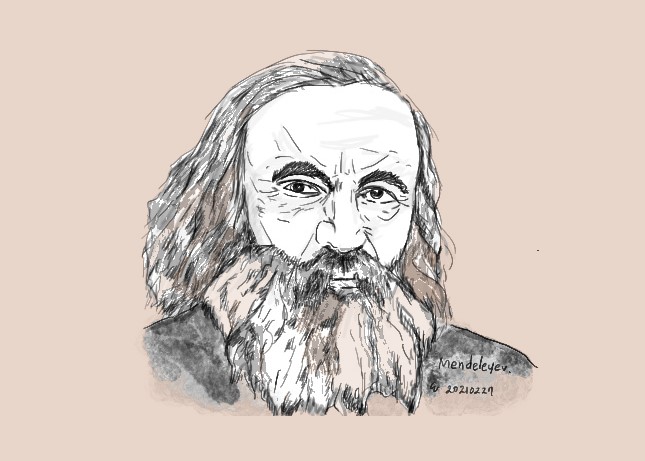“Suhelive boric acid planeta… ”You will remember the memorizing technique of the periodic table of the elements that you steadily memorized in school. Sounds like a weird spell, but’Suhelive… ‘Is after the first letter of each element name. ‘Number’ means atomic number 1 hydrogen,’Hell’ means 2 helium, and’Lee’ means 3 lithium.
I remembered it randomly, but hidden in this periodic table of the elements is a great deal of information that sheds light on the history of human science. The periodic table of the elements, developed by Dmitry Ivanovich Mendeleyev and Henry Moseley, allowed mankind to predict the properties and correlations of atoms, and through this, mankind was able to lay an important foundation in chemistry.
Dmitry Mendeleev made the periodic table according to the mass size of the elements
Alchemy was prevalent in the 17th century. Alchemists tried to extract gold from cheap metals. They even used various methods to extract gold from the urine. At that time, since there was no concept of an element, we extracted’Phosphorus’ rather than’gold’ from urine, but we did not know exactly what it was. Alchemists thought that phosphorus obtained through urine was an imaginary substance considered to be the highest value that can be obtained through alchemy, the sage stone.

Dmitry Mendeleev, who devised the early periodic table of the elements. Ⓒ Kim Eun-young/ ScienceTimes
It wasn’t until the 18th century that phosphorus was precisely defined as an element. French chemist Antoine-Laurent de Lavoisier proves the concept of’element’ as claimed by Robert Boyle in the 17th century through experiments. He published 33 basic elements and clarified the concept of the element, proving Boyle’s theory of claiming that the element is’a substance that can no longer be decomposed experimentally’.
In the 19th century, scientists have studied the associations between elements by systematically classifying and arranging the various elements discovered. Russian chemist Dmitry Mendeleev was one of them. He arranged the elements in order of mass order, revealing that there is a periodicity between the elements. Schematic of this is the beginning of the periodic table of the elements today.

Part of the periodic table hand-drawn by Mendeleev. © Wikimedia
Mendeleev published a periodic table of 63 elements in increasing order at the Russian Chemical Society in 1879. The periodic table has become a major milestone that makes it easier to understand and study chemistry today, as it is said,’Even if you understand the periodic table alone, you know half of chemistry.’
Mendeleev is nominated for the Nobel Prize in Chemistry for his work in devising the early periodic table. Unfortunately, however, the award is missed by a single vote for French chemist Henri Moissan, who successfully separates fluorine. Later, Mendeleev died months before winning the Nobel Prize.
However, Mendeleev’s insights, apart from winning the Nobel Prize, are still shining widely into the present day. In addition to the elements discovered at the time, he was a genius who predicted that additional elements would be discovered in the future. So there were’blanks’ in his periodic table that would be filled with elements discovered in the future. Mendeleev’s Periodic Table of the Elements was able to be developed into the present periodic table through a process of modification to include additional elements discovered by later scientists.

Mendeleev’s Periodic Table. Ⓒ Wikimedia
XHenry Mosley completes the modern periodic table with line spectrum experiments
Mendeleev’s periodic table was great, but it is quite different from the periodic table we use today. Based on Mendeleev’s periodic table, the periodic table created by British physicist Henry Mosley will give the appearance of the modern periodic table. He organized Mendeleev’s periodic table in order of atomic number.

Henry Mosley completes the modern periodic table with X-ray spectrum experiments. Ⓒ Wikimedia
By rearranging the periodic table by atomic number, Mosley solved a problem with Mendeleev’s periodic table. He organized the periodic table by atomic number because he was able to prove that the chemical properties of all elements are determined not by the size of the atomic weight, but by the atomic number. This result was due to his study of X-rays. Henry Mosley is a student of Ernest Rutherford, who discovered the atomic structure of X-rays. He studied radiation under him before turning to X-ray research.

Modern standard periodic table of elements. Ⓒ Wikimedia Commons
Mosley measures the intrinsic X-rays of each element and finds that the frequency of the X-rays unique to each element emanating from the atom is approximately proportional to the square of the atomic number. That’s Mosley’s Law. Mosley’s law was applied to locate an element with an unclear atomic number on the periodic table.
Mendeleev, who initially conceived the periodic table, and Henry Mosley, the genius who provided the basis for the periodic table we use today. However, in many ways, the relationship between the geniuses of the periodic table and the Nobel Prize did not reach. As Mendeleev did, Mosley died in the Battle of Gallipoli in World War I before winning the Nobel Prize, leaving her sad.
(27)
